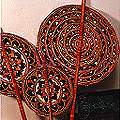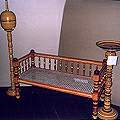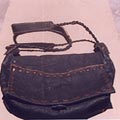Two distinct types of lac-work are done in Sri Lanka. One of the techniques is found in Matale district, in the central part of the country at a distance of about 160 kilometres from Colombo; the other technique is from the southern part of the country. The lac work from Matale is the more distinctive one of the two; however, in neither styles is there any use of the brush. This is distinct from other kinds of lac-work: lacquer varnish work from Japan makes use of the brush, while in the island-country of Maldives next to Sri Lanka, lac is applied by turning, but incised after that, a process that is also used in the lac boxes made in Sindh in Indian sub-continent.
Hapuvida in Matale district is held to be the place of origin of this craft; here it has been in existence for nearly a century. Unlike in the neighbouring Kandy district and in Matara district in the southernmost tip of the island-country, where the craft is no longer practised actively, lac-work remains an active craft in Matale even today.
HISTORY & TRADITION
Lac work in Sri Lanka was traditionally linked with the making of implements like bows, arrows, spears, staves, and banner-poles: this explains the organisation of the lac work artisans of Sri Lanka into a group known as I-Vaduwo or arrow-makers, under the leadership of a chief by the name of Hangidiya. The lac-workers essentially practised wood-turning, though they also executed the ornamentation on the product.
Aside from implements, examples of traditional lac-work can be found in the painted ornamental windows in the edifice of the Temple of the Tooth Relic or Dalida Maligawa in Kandy. Lac-work is also found in some old-style mansions. Most of the work is limited to a few conventional patterns that are executed with skill; more complicated patterns, however, lack finesse.
RAW MATERIAL
The lac found in Sri Lanka is derived from two species of insects. (It is different from Indian lac.) One of the insects is the keppitiya or kon-lakada (Tachardia Albizziae, green) which is found on several trees like the keppitiya (Croton Aromaticus), kon (Schleichera Trijuga), and hinguru (Acacia Caesia); the other species of insect is Tachardia Conchiferata (green also called Telakiriya Lakada), which is found on an euphorbaceous plant called telakiriya or Excoecaria Agallocha. The latter is a rarer species but the lac produced is brighter and clearer.
PROCESS & TECHNIQUES
1. THE MATALE METHOD
The Matale method of lac-work is also known as the niyapoten veda or finger-nail work. This is because the work is done with the finger or thumb nail; no lathe is employed. Freshly collected twigs with lac insects on them are dried in the sun, after which the resin is then removed, pounded, winnowed, and sifted. The lac that is thus obtained is crushed and enclosed in narrow bolster-shaped bags of thin cloth. These bags are heated over charcoal fires and twisted till the melted lac oozes through the cloth. The lac is scraped off, and a part of it softened over a fire and attached to the point of a small stick. Another portion is then warmed and attached to a second stick.
This softened lac is then drawn out between the two sticks, worked about, doubled up, and redrawn several times until it assumes the form of a long stout ribbon of glistening fibrous lac that is a bright golden-brown in colour. The pigments are mixed into the lac at this stage by softening it and pounding the coloured powders into it. The four colours used in lac work are red, yellow, green, and black. The red is derived from vermilion, or sadilingam, or cinnabar, the yellow is from orpiment or hiriyal, the green is obtained by adding ‘dhobie’s blue’ or washerman’s blue to yellow (formerly punil or indigo was used), and black is prepared by combining badulla (Semecarpus Gardneri) milk, keppitiya lakada (stick lac), hal-dummala (resin from the Hal tree, Vateria Acuminata), and old jak milk in equal parts; these are ground together and warmed. Synthetic imported materials, are, however, gradually replacing these indigenous sources.
The technique of niyapoten veda is explained in detail through the example of the lac decoration of a wooden staff. The stick is first shaped and smoothed. The lac worker sits on the ground, with a chatty or gini kabala (a container with a charcoal fire) before him. He has with him short sticks with a lump of coloured lac at the end of each, as also a short strip of puskola or Talipot leaf or Corypha Umbraculifera. The stick is first coated with the ground colour, usually red, after which it is warmed over the fire. Lac is then applied over it, and pressed and smoothed out with a talipot leaf: through this process, the stick is still kept warm over the fire. Gradually, the entire stick is covered with the coating of red lac.
The next stage involves the execution of the pattern. The lac is drawn out into strips of the required thinness. The lump of lac is warmed then a small piece held between the finger and thumb, while the rest is pulled away, leaving a long thin connecting thread which is wound round the bent knee of the lac worker and formed into a skein. When the lac becomes cold it has to be warmed again. To transfer the lac onto the stick, the stick has to be warmed gently and turned continuously; this is usually done with the help of an assistant, who usually sits behind the lac-artisan. One end of the string of lac is attached to the stick by pressure, and the rest of it added likewise as the stick is turned. Once one revolution is completed the thread of lac is cut off with a thumb-nail. After this the stick is warmed again and smoothed with a leaf. When the patterns are very complex, string-lac is applied in the same way and then nipped off with a nail. Dots are created by applying the thread of lac and cutting off the end with the nail. Some of these dots are, therefore, square or diamond-shaped.
2. Lac-Turney
The other technique of lac-work in Sri Lanka is found in the southern part of the island in the Matara district. This technique of lac turney has been borrowed from India on the initiative of a master craftsman. Here the lac is applied to the wood while it is revolving on a turning lathe: the heat caused by friction softens the lac and causes it to adhere. The stick of lac is held against the object as it revolves on the lathe. This process is limited to objects that can be turned on a lathe; it is usually confined to round or cylindrical objects. The object is itself made by the artisan by turning on the lathe, and is prepared for the application of lac by smoothening the surface with sand-paper; the traditional method of smoothening was by using the leaves of the sand-paper fig or Ficus Asperrima.
The delicate pattern-work possible with the finger-nail is not possible in lac-turney. The only design possible is concentric bands of colour, usually applied to the different parts of small tables, chairs, tom-tom frames, and walking-sticks. Some examples of this kind of lac-work include old Kandyan lac-striped round-boxes (abharana heppu), bed-legs (enda kakul), and betel-leaf/nut stands. The main types of woods used for this kind of lac-work are panakka and suriya, but owing to a big scarcity in these, substitutes are being used.
Designs in monochrome are also done in lacquer work; for example, white on a black background. This is done by laying coats of two colours on the surface: the first layer being the colour in which the design should appear and the second layer is the background colour. The design is then carefully cut on the upper layer exposing the coloured design on the lower one. In all the processes the final smoothening and polishing is done first with a strip of Talipot leaf and finally with a piece of rag.
Nowadays this geographical distinction in the two types of lac work is not as rigid: both these traditions are being practised in both the areas. The traditional method of obtaining lac is also less common now; craftsmen are increasingly using shellac imported from India. This shellac is mixed with the dyes to obtain the required colour.

MOTIFS & DESIGNS
Owing to the technique, lac work done on a lathe is limited primarily to concentric patterns; however, lac work done with the finger-nail allows for more complex patterns and motifs.
1. FLORAL PATTERNS
-
The picca mala or kekulu mala (jasmine flower motif) is so called because of its resemblance to buds. This motif is used in its natural form, and usually forms a sinuous pattern on a circular object. This popular motif is usually set in white against a dark background.
- The sera adiya or vel pota is also described as the ‘linked honeysuckle’ by Ananda Coomaraswamy; there are several variations of this motif and it is used generally as a border design. This design is seen in the lac-work on walking sticks and staffs. A combination of four different vel potas in a single motif is known as hatara vel pota.
- The kalasdangaya, also known as tundan veda, is a floral design enclosed in a geometrical framework. When this framework resembles a water-pot the design is known as kalasdangaya.
- The kol vela is an interlacing branch or vine pattern; the suli vela is another vine pattern.
- The dela is a motif depicting a floral formation.
- The pala peti is a petal pattern.
- The bo-kola is a pattern depicting the leaf of the Bo (Pipal) tree.

2. GEOMETRICAL PATTERNS
- The arimbuwa is a geometrical design that consists of a row of small circles and dots set between two parallel lines; this is generally used as a border framing a design.
- The panawa is a design consisting of parallel lines drawn very close to each other. In lac work, it is usually found in combination with the arimbuwa design. This is yet another border design, used as a frame.
- The adara kondu refers to the design of straight lines, most frequently found in lac-turney products, like walking sticks or handles of ceremonial fans. They are also found in sesat work.
- The pathura or isosceles triangle or chevron is seen in its elongated form in lac walking sticks, handles of sesat and weapons.
- The binduwa is a dot pattern, usually found in a linear arrangement as a part of a composite design.
3. MISCELLANEOUS PATTERNS
- The suliya is like a scroll design, with several variations: the thani suliya or single scroll, the suli deka or double scroll, and the suli vela or continuous scroll. These designs are almost always interspersed with dots and straight lines at regular intervals.
- The diyarella is a motif representing a series of waves gently rising and falling. Several variations of this design, which Ananda Coomaraswamy describes as a chevron or a zig-zag pattern, are found, some of them fairly angular.
- The lamu geta is a plait pattern.
THE PRODUCT RANGE
1. COMMON PRODUCTS
In the Kandyan period in Sri Lanka, lac work was the accepted method of embellishing railings, chairs, jewellery boxes, and book covers adding a distinctive charm to the object. Nowadays lac-work is found on walking sticks, powder-boxes, vases, ash-trays, and lamp-stands. This technique is also used to decorate tall lamp-stands and large tables with stripes of colour in attractive designs. The latter is usually done in the lac-turney method.
The lac work done with the finger-nail is used to decorate a large variety of articles like wooden sticks of various kinds (staffs or herimiti), handles of ceremonial spears, banners, fans, and sesat; in ancient times it was also used for powder horns or vedibehet karaka, oboes or horane, and book covers or pot kambi.
2. ORNAMENTATION IN IVORY, HORN, BONE, & SHELL
Lac is also used as an inlay in ivory, horn, and chank work. In ivory inlay, the ivory is incised with lines and circles, which are filled with coloured lac. In the case of turned ivory or horn, this process is done by holding a piece of lac against the piece as it revolves on a lathe. The lac is heated up with the friction and fills up the incised grooves. The craft work done in Kandy confines the designs to incised lines and circles and is very similar to the work done at Jodhpur in Rajasthan in India. Flat plates of ivory are inlaid with scroll and floral ornament designs which are used in the fittings of calamander wood boxes found in the southern district of Matara; this is similar to the method of decorating ivory used in musical instruments made at Tanjore district in Tamil Nadu in southern India.
3. THE SESAT WORK OF SRI LANKA
Sesat work is very closely connected to lac work. Both are traditional crafts unique to the region of their origin and growth, mainly the Matale district in the central part of Sri Lanka. The craft of making sesat or ornamental sun-shades and fans is dependant on the supply of lac-handles to which they are fixed; thereby this is a combination craft where lac work plays a prominent role. The villages of Hapuvida and Unaweruwa in Matale district where lac work and sesat work are done respectively, have maintained their traditional occupations exclusively among their families where all the family members collectively contribute in the craft-process. Now there are only about 20 families which practise this craft.
This craft is believed to have been introduced into Sri Lanka by the craftsmen who came with the group of artistes carrying the sacred Bo tree in ancient times. Sesat or av-atu is a kind of sun-shade or a large, round fan that was used in the ancient times in processions of royal and religious ceremonies. It was used to protect royalty and the chieftains from the heat. Now these serve as decorative emblems in the form of circular patterns woven into discs and fitted onto staves. Sesat staves are combined with emblematic spears as part of decoration.
Sesat fans are made using the Talipot palm, mica, paints, and the decorated lac staff. The item is considered complete only in the presence of the lac staff, which gives the product lustre and enhances its appeal. The tools used in sesat-making are quite simple. The palm leaves are boiled, coloured and arranged in circles and sewn to form a design. The main design used is the lotus flower, which forms the basis of arranging the layers. The lotus flower, a very traditional Sinhalese motif, is mainly used in its geometrical form within a circle. Here it is divided usually into 4, 8, 16, and 32 petals; more petals can be introduced but the total has to be a multiple of four.
Geometrical patterns like the havadiya are also used to make the product attractive; this motif is also known as weldangaraya and havadidangaraya and is a chain motif with different variations. As the number of circles in the design of the sesat increases, the product gains in value. On an average a sesat product has about three circles. Government craft outlets are the main marketing channels for sesat products. Private and public institutions buy these products for ceremonial occasions.
PRACTITIONERS & CRAFT LOCATIONS
In Sri Lanka, lac artisans are limited in number: today, less than 50 families are engaged in lac work. However, the government is actively encouraging this traditional craft by providing facilities such as service centres for craftsmen and Master Craftsmen training classes for the young. Marketing channels are also being created for the products.
Craft Locations:
- Hambantota district (southernmost tip of the country): The villages of Angulumaduwa and Pahala Beligalla.
- Kalutara district (south-western coast): The village of Wekada.
- Kandy district (about 227 kilometres from Colombo): The villages of Kalapura and Hurikaduwa.
- Matale (central part of the country; about 160 kilometres from Colombo): The villages of Pallehapuvida, Neluwankanda, and Mausagolla.
- Ratnapura district: The villages of Malangama, Hiramadagama, and Balangoda.
CONCLUSION
Sinhalese lac work is characterised by great brilliancy and gaiety in colouring. There is a need to preserve this traditional craft with suitable innovations to meet contemporary needs. However, change has also necessitated compromises. Today shellac has emerged as the alternative that is sometimes applied like a paint to make the whole process much faster. This may give a high degree of colour and brightness to the products but traditional quality is compromised. The impact of climactic changes on these products also needs to be considered in context of innovations.
Gallery
YOUR VIEWS
PRACTITIONERS: INDIA
Access 70,000+ practitioners in 2500+ crafts across India.
BIBLIOGRAPHY
10,000+ listings on arts, crafts, design, heritage, culture etc.
GLOSSARY
Rich and often unfamiliar vocabulary of crafts and textiles.
SHOP at India InCH
Needs to be written.






